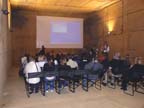
Now celebrating its 40th edition, Marmomacc, the International Natural Stone and Technology Exhibition, will once again take place in Verona, Italy, as a leading international trade fair in the natural stone sector. And the event - which will be held from September 29 to October 2, 2005 - not only features a solid exposition with international exhibitors and attendance, but it also has an extensive program on the use of stone in architecture and design.
Last year's edition of Marmomacc featured 1,428 exhibitors, including over 600 international firms from 48 countries, displaying over a net area of 680,000 square feet. It was attended by nearly 62,000 professionals, including over 22,000 foreign visitors hailing from 117 different nations. Additionally, signifying the international importance of the fair, it was also visited by 252 accredited journalists from 24 countries, 30 international delegations and thousands of architects and designers, including more than 100 selected and invited directly by VeronaFiere, the organizer of the event.
Exhibitors from around the world have used Marmomacc as a platform to introduce their latest product developments. On the stone materials side, this has meant new slab materials from around the world, mosaic designs, tile patterns and other product innovations. And on the technology side, companies have used Marmomacc to introduce new large-scale stone-working machinery, diamond tooling, resin products, maintenance solutions and more.
Recently, Marmomacc signed a strategic collaboration agreement with StonExpo, the North American trade show taking place this October in Las Vegas, to promote to the international stone sector. The agreement will provide exhibitors and visitors even greater benefits through joint activities by the two organizations in terms of both exhibition attendance and training opportunities. “Cooperation with Hanley Wood Exhibitions, the leading organizer of show events as well as the largest U.S. publishing group in the building and construction field, will improve visibility of our event in the U.S. market and enable us to reach even more producers, suppliers and even architects - thanks to their capillary network of contacts,†said Luigi Castelletti and Giovanni Mantovani, president and director general of VeronaFiere in a joint statement.
Both events are renowned for their training in the natural stone sector. “Since 1999, VeronaFiere has been one of the official education providers for AIA, the American Institute of Architects, organizing training courses for architects in the use of stone materials in contemporary architecture,†explained Mauro Albano, brand manager of Marmomacc, who noted that StonExpo also issues credits valid for AIA continuing education.

Architectural events
The 40th Marmomacc will also host the 9th edition of the “International Stone Architecture Awards,†a biennial event organized by VeronaFiere that has become an important event in the sector.The jury includes well known figures such as Alfonso Acocella (University of Ferrara), Vittorio Magnago Lampugnani, (ETH, the Swiss Federal Institute of Technology in Zurich), Werner Oechslin (ETH, Zurich), Vincenzo Pavan (co-director USA Institute Italy) and Antonio Pizza (Escuela Tècnica Superior de Arquitectura de Barcelona).
Award-winning projects are as follows:
• Rodolfo Machado & Jorge Silvetti Architects, Boston Public Library, Boston, MA - The “Allston Branch†of the famous Boston Public Library takes up the concept of “distributing†culture to the suburbs of the large city. This public character emerges in the “alternative†design (volumes, inverse slope of the roofs) and materials; stone clearly indicates the public character.
• Alberto Campo Baeza, Offices of Provincial Health Delegation, AlmerÃa, AndalucÃa, Spain - This work is a metaphor of blocks of stone in a rigorous and interpretation of thin cladding. Continuity, co-planarity, homogeneity and monographic stone are the main material values and ultimately the linguistic approach to architecture itself.
• Pedro Pacheco and Marie Clément, Cemetery, Church of Our Lady of Light and Museum of Light, Aldeia da Luz, Mourão, Portugal -This project aims to create a micro-setting for a new foundation where the museum plays a central role, emerging as the essential link with the existing church and cemetery area being placed in a different context. The museum building was interpreted as a landscape element, and the schist-like material used in the cladding and the construction of certain walls blends with the profiles of the landscape.
• Antón GarcÃa Abril / Ensamble Studio, Centre for Musical Studies, Finca Vista Alegre, Santiago de Compostela, Spain - This work combines and bonds two opposing aspects in a single element, displaying precision of the design with the rough irregularity of “as quarried†stone material. Large slabs - mounted like blocks - have been arranged as in a quarry depot. The external volume is matched by the elegant layout of the interior spaces, which were designed to ensure superb natural lighting.
• Claudio Silvestrin, Giorgio Armani Stores, Paris, Milan, Düsseldorf, Florence, Moscow, Naples, Boston, Chicago, Edge Mesa, Tokyo, Atlanta, Athens, Vienna, Zurich, Jeddah, Beijing, Dubai, Busan, Barcelona, Rome and London; Sao Paulo, Hong Kong, Seoul and Shanghai - In the globalized world of fashion and retail, the Giorgio Armani boutiques designed by Claudio Silvestrin stand out through the harmony between image, content and style. Brand recognition is not achieved, as is often the case, through heretical gestures repeated with arrogant indifference, but thanks to ductile repetition of quiet and elegant architecture where spaces are unified by sophisticated cladding in light-colored natural stone.
The “ad memoriam†award dedicated to past authors renowned for major contributions in stone architecture was made to Franco Albini (1905-1977) for the Treasury Museum, San Lorenzo, Genoa, 1952-1956, a project that became very famous in its own time. This work, one of the most successful by Albini embraces precious and highly skilled expressions of an ancient building culture that has long since been forgotten.
The awards will be presented on October 1, 2005, at VeronaFiere, within the scope of a ceremony during which the winners will illustrate their works to a large audience of architects, engineers, university students and tradesmen. An exhibition of the projects - with drawings, photos and models together with samples of the stone materials used - will be on display from September 15 to October 4.